![]() IDEAS
IDEAS
![]() Tweet
Tweet
 Vacation
Rentals
Vacation
Rentals
![]()
|
Made With |
|
|
|
|
Dr. Hoffer's Travel WebSite This site was last updated 05/18/13 |
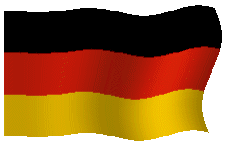

![]() PARIS10 #5 Pinakothek
der Moderne
PARIS10 #5 Pinakothek
der Moderne
![]()
munich flag upper right

Friday August 20, 2010
Munich or
M�nchen (Muenchen if you don't have an
umlaut U) was 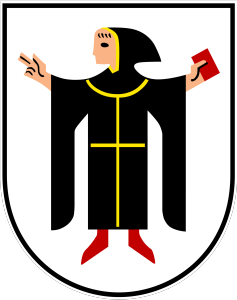 founded
founded
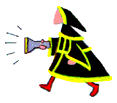 in
the year 1158. The city emblem is on the left. For information on sites in Munich click on this little monk with
the flashlight.
in
the year 1158. The city emblem is on the left. For information on sites in Munich click on this little monk with
the flashlight.
The city is located in the southeaster part of Germany and is the capital of the Free State
of Bavaria. It has a present day area of 119.86 mi2 (310.43 km2)
at an elevation of 1,703 ft (519 m.) The population is 1,330,440 ('09)
giving it a population density of 11,100/mi2 (4,286/km2)
with a surrounding urban population of 2,606,021 and the entire metro Munich is
5,203,738. 300,129 of those do not hold German citizenship. Below is
a small portion of the metro area.
located in the southeaster part of Germany and is the capital of the Free State
of Bavaria. It has a present day area of 119.86 mi2 (310.43 km2)
at an elevation of 1,703 ft (519 m.) The population is 1,330,440 ('09)
giving it a population density of 11,100/mi2 (4,286/km2)
with a surrounding urban population of 2,606,021 and the entire metro Munich is
5,203,738. 300,129 of those do not hold German citizenship. Below is
a small portion of the metro area.
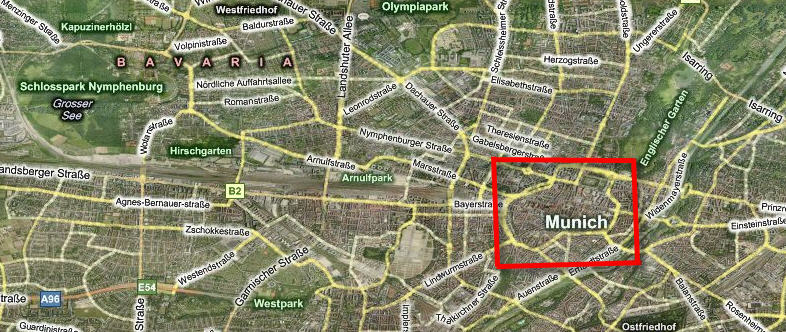
The oldest central city, the Altstadt (red square) is shown in detail below.)
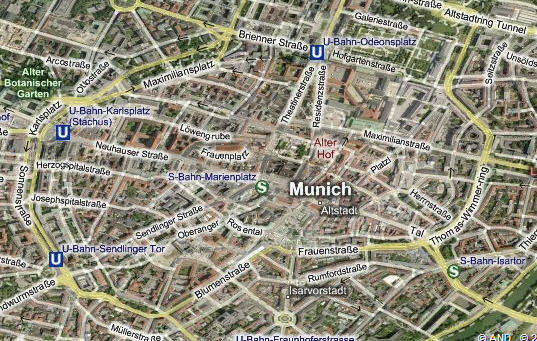
The local rivers are the Isar and the W�rm. The city has strong Turkish and Balkan communities. The largest groups of foreign nationals are Turks (43,309,) Albanians (30,385,) Croats (24,866,) Serbs (24,439,) Greeks (22,486,) Austrians (21,411,) and Italians (20,847). 37% of the foreign nationals come from the European Union. With only 24,000 inhabitants in 1700, the population doubled about every 30 years. Munich has become Germany's third largest city. 47.4% of Munich's residents are not affiliated with any religious group; 38% of the city's inhabitants are Roman Catholic, 14% Protestant and 0.3% Jewish. Several national and international authorities are located in Munich, including the Federal Finance Court of Germany and the European Patent Office. The city was heavily damaged by allied bombing during WWII, being hit by 71 air raids over a period of six years.
I woke at 4:30, 5:20, 7:40 and got up at 10:10 AM. I took a longer route (map below) on Hotterstra�e around the corner from the hotel passing by this cute little place I have passed many times, called Hundskugal [18 Hotterstra�e, +49-8-926-4272] {reviews} (below left & below) which claims to have been there continuously since (zeit) the year 1440.
.jpg)
I stopped in and looked at their menu and thought that we should try it some time. The below aerial maps shows how close our hotel (on left) is to Marienplatz (on right) and shopping. Compare the map from Google on the left and the Bing map on the right. Quite a difference.
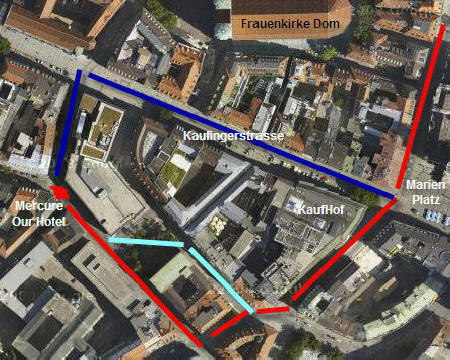
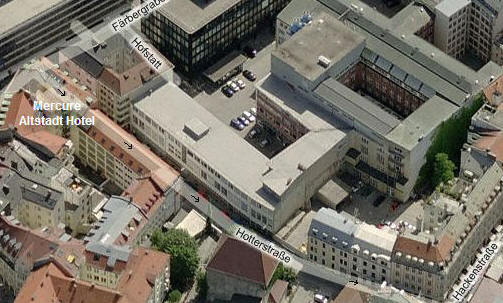
The route we take through Kaufingerstra�e is shown in blue
(above) and
the one I took this morning down Hotterstra�e is in red. The short cut I
usually take is shown in green, crossing through the parking lot. We are
also close to the Cathedral (Dom) Frauenkirche (above top, and below left.)
I turned left on
and on to Brunnerstra�e (red
line) and ducked into the underpass.
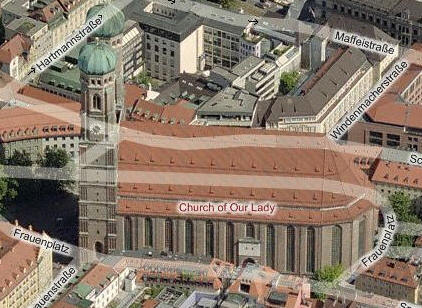
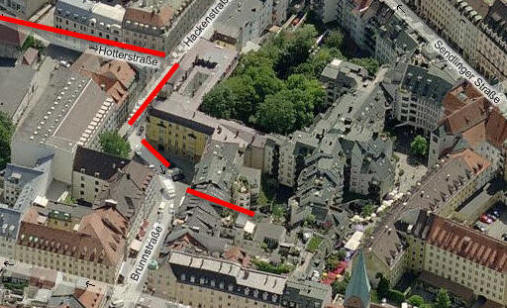
Last night the waitress at Bricelta told me they had free WiFi, so at 11:00, I arrived back at Bricelta (below right) and ordered a cappuccino. It wasn't long before I discovered that they didn't really have free WiFi and the cappuccino was so so.
[Above left is Hundskugal ] Bricelta is located in a little courtyard and while enjoying the great weather and ambience, I took these photos of this interesting plaque in the ground (below left) and this humorous statue (below right.) The plaque reads "*Cosmas Damian Asam * Egid Quirin * Asamhof 1983." It is a dedication to the Asam brothers (Cosmas Damian Asam and Egid Quirin Asam) who built the beautiful church around the corner as a private church but were forced to make it available to all due to public outcry.
.jpg)
I discussed them in the Germany Diarios. The courtyard is amongst the umbrellas (below left and right.) The Asamhaus (Asam House) referred to (built in 1733) is to the left of the church (below right) on Sendlinger Stra�e.
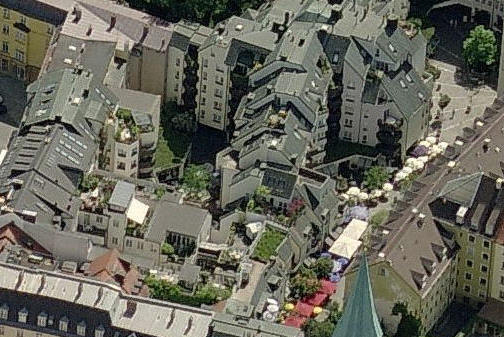
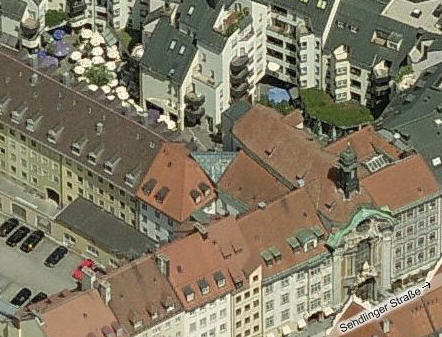
I picked up and headed out at 11:55 and stopped at Rosen Apoteke and by 12:10 I was back at San Francisco Coffee Co. and got a much better cappuccino. I got online and finished my AOL email, did a JCRS journal review, worked on my book, emailed about my broken Archos unit and at 2:00, made a few business calls. At 3:50, Marcia arrived and she had lunch. We had planned to visit one of the art museums today so we headed out. At 4:10 we left Odeonsplatz and walked up Brienner Stra�e (below)...

...and down Oskar-von-Miller Ring, then Gabelsbergerstra�e; turned right on Barer Stra�e and arrived at our destination (map below.)
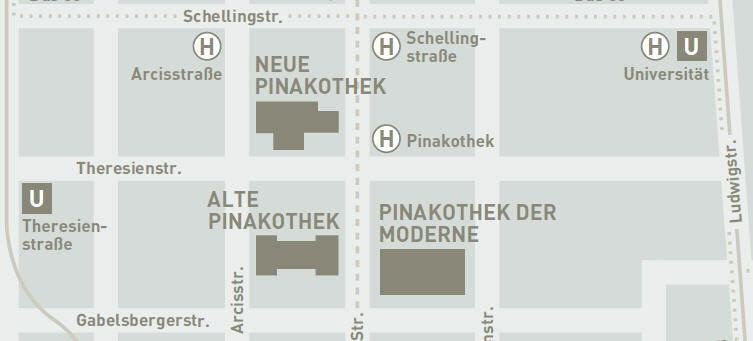
.jpg)
.jpg)
At 4:30 we entered the Pinakothek der Moderne [40 Barer Stra�e, +49-892-380-5360.] The entrance fee was �10 for Marcia, but only �7 for me (a senior.) They tend to think I'm pulling a fast one until I show them my driver's license. They give you a pin to wear (left end of tickets above.) Its closed on Monday and only �1 on Sunday. For a map of how to get there click here.

The Kunstareal district in Munich, partly shown in the Bing map above, consists of the following museums: K�nigsplatz, Glyptothek, Staatliche Antikensammlung, Lenbachhaus, Alte Pinakothek, Neue Pinakothek, Pinakothek�der Moderne, Museum Brandhorst, Staatliche Graphische Sammlung M�nchen, and Staatliche Sammlung f�r �gyptische Kunst.
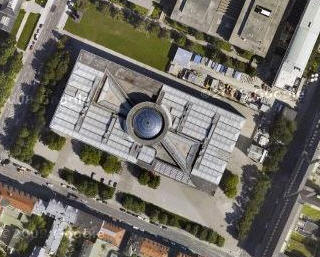
Above left is the exterior of the museum with an aerial view (above right) showing the Rotunda and below are the various floor plans.
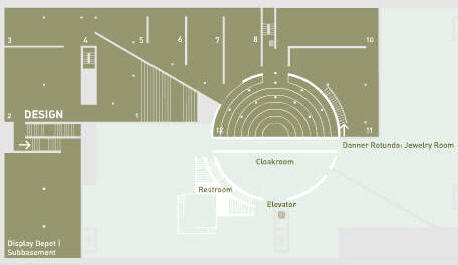
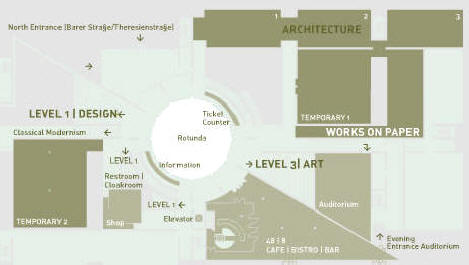

You can see there are many rooms to explore and we are getting a late start, as usual. We entered and took the elevator to the top floor and all we found there was this huge circular skylight which was quite impressive.
.jpg)
From here (above) Marcia is looking down at the other floors (below.)
Below is the shot I got of the beautiful Rotunda from below using my technique.
As we started the tour of the art, the first display was this jumbled bunch of stone logs filling an entire room called "The End of the 20th Century" by Beuyes.
.jpg)
The
next piece is a large bronze titled "Der Gest�rzte"
by Wilhelm
.jpg) Lehmbruck.
[Couldn't find translation for the title.] The displayed tags (right,) which I photographed, list the artist's name, birth
(Duisburg in 1881,) death (Berlin in 1919) and then the title and date of the
piece at the bottom.
Lehmbruck.
[Couldn't find translation for the title.] The displayed tags (right,) which I photographed, list the artist's name, birth
(Duisburg in 1881,) death (Berlin in 1919) and then the title and date of the
piece at the bottom.
Here is a series of photos I took of some of the Masters they have here.
.jpg)
.jpg)
Above: Kristallschale means crystal bowl and F�cher means fan.
.jpg)
.jpg)
Above: "Woman with Mandolin" and "Landscape with Yellow Church Steeple"
.jpg)
.jpg)
Above: "Traumatic Improvisation" and "Composition"
.jpg)
Two by Dali; above "Apotheosis of Homer" and below "The Mystery of Desire" or "My Mother, My Mother, My Mother"
.jpg)
.jpg)
.jpg)
Above: "House Angel" and "The Great Carnival"
.jpg)
.jpg)
Above: "The Light and a Number of Things" and "Maternity"
.jpg)
.jpg)
.jpg)
Above: The famous "Madam Soler," "The Artist and His Model" and "Sitting Woman"
.jpg)
.jpg)
Above: "Landscape near Mougins II" and "Woman"
.jpg)
.jpg)
Above: "Still-life with Geraniums" and "Temptation of St. Anthony"
Below are examples of the hallways (left) and art display rooms (right.) It is the room displaying the triptych above right.
.jpg)
.jpg)
Above: "Fernandez" and "Bathtub"
Below is a Van Gogh (below left) from 1889 entitled "Field of Wheat with Rising Sun." and a sculpture entitled "Ascent" by Otto Freundlich.
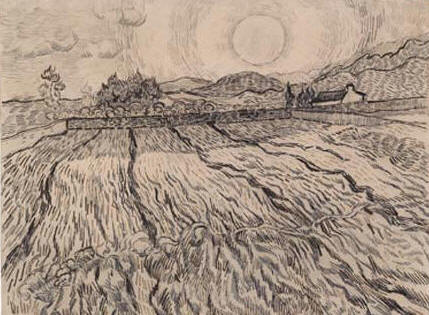
.jpg)
.jpg)
Above: "The Crucifixion" by Bacon.
.jpg)
.jpg)
They have a special paper exhibit from Staatliche Graphische Sammlung by Norbert Tadeusz called "Work of Paper." Below are examples of some of them. There are some I wouldn't show here.
.jpg)
.jpg)
.jpg)
Above: "Nude Sculptures" and "Gynecology I" and "Gynecology II"
You are drawn to walk down to the lower level to see the design exhibit (below.)
Here, the Italian company Alessi, has an exhibit called "The history and future of Italian manufacture and design: Objects and Projects." It included many old "future" vehicles.
.jpg)
I was ready to leave and while looking for the exit, I discovered another whole section of the museum. Marcia went to the museum store while I explored it quickly. They had a large display demonstrating the pre-war condition of many famous German and European sites, how they looked after the bombing and then how they looked after restoration. Here are examples of a number of them. The first is Leonardo DaVinci's mural of the "Last Supper" ("Ultima Cena") in the chapel at Santa Maria delle Grazie in Milano, Italy, that we visited in 1997 and again in 2000 after restoration work.
.jpg)
Below is the Gr�nes Gew�lbe (The Great Green Cabinet) in Dresden, Germany I visited in 2007 in the pouring rain.
.jpg)
Below is the Residenzschloss in Dresden I visited in 2007
.jpg)
Below is the Cuvilli�s Theater here in Munich I will be seeing soon.
.jpg)
Finally, below is Odeonsplatz here in Munich.
.jpg)
Below is
.jpg) one
of the Campanille in San Marco Square in Venezia, Italy. This wasn't
bombed in WW II, but rather it was felled by an earthquake in 1902. The
original (left) was built between the 10th and 12th Century.
one
of the Campanille in San Marco Square in Venezia, Italy. This wasn't
bombed in WW II, but rather it was felled by an earthquake in 1902. The
original (left) was built between the 10th and 12th Century.
.jpg)
They also have a section dedicated to architecture.
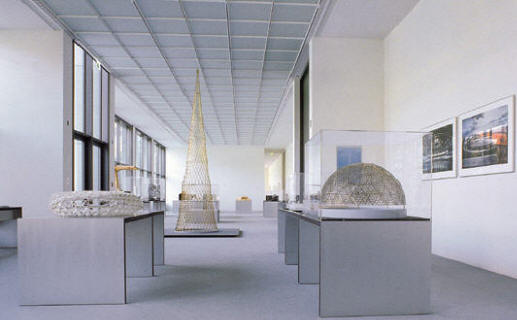

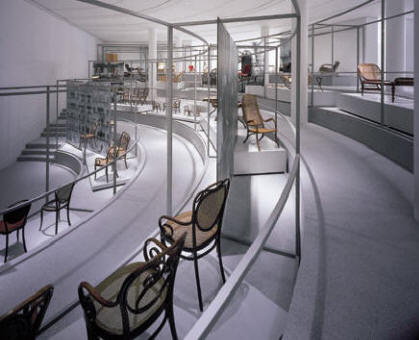
There was this very large room with many things on display I didn't understand but the mechanical thing in the left photo is called "Perpetuum Mobile of the Present."
At 5:30 Marcia bought a postcard at
the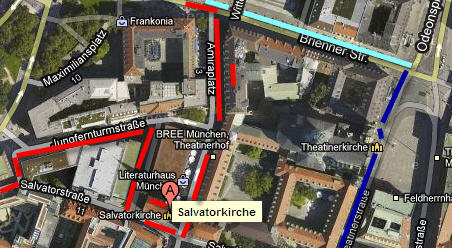 Cedon Museum Shop for �1 and then at 5:40 we walked all the way back to the hotel.
We decided to feel our way back on a different route using my "compass" to head
for the hotel. The map on the left shows the route to SFCC in blue, our
route to the museum in green and our route back in red.
Cedon Museum Shop for �1 and then at 5:40 we walked all the way back to the hotel.
We decided to feel our way back on a different route using my "compass" to head
for the hotel. The map on the left shows the route to SFCC in blue, our
route to the museum in green and our route back in red.
On the way back we first had to find a way to navigate across this wide street (below right) that was like a freeway with plenty of traffic. The church there (left & right) is the Sankt Markus Kirche and that large white complex in the distance (left) is Siemens.

We then came across the Palais Pinakothek [4 T�rkenstra�e, +49-892-380-5284, palais@pinakothek.de] (below) and it was too late to go in.
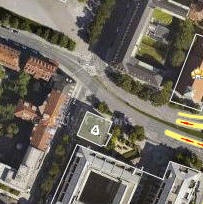
This was originally built as the Palais D�rckheim in 1842 for the Count. It later became the Prussian embassy to Bavaria in 1855, a Gestapo police hospital, and a bank which donated it to the Pinakothek Museums. They use it for art education.
Then we passed this impressive structure, the Gallerie Thomas Modern [16 T�rkenstra�e, +49-892-900-0860.] It is dedicated to the presentation of advanced and younger artists from the contemporary field. We didn't have time to explore it.
Below are two works displayed there. On the left is "The Metamorphoses of Norma Jean" by Robert Indiana (remember him from the EAT sign in Maine?) and on the right is "Jellyfish Eyes" by Takashi Murakami.
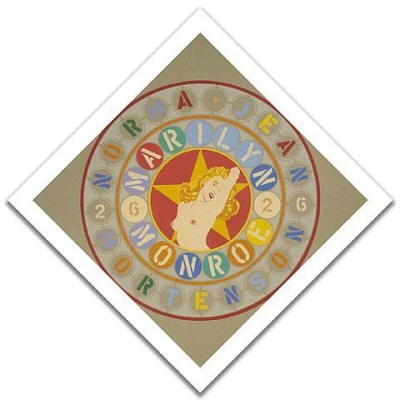
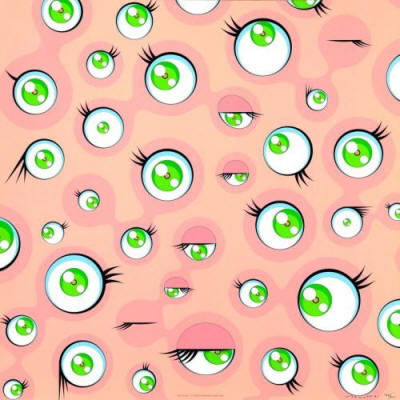
As we kept walking, we came across this large modern blue complex of the Bavarian Landesbank (below.)
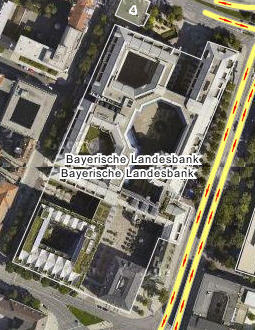
Going down Amiraplatz we came across
this quite
![]() ornate building
(below) called the Bayerische Hypotheken Wechselbank which I later discovered
became the
HypoVereinsbank. It had fine examples of caryatids (below right) above
the main entrance.
ornate building
(below) called the Bayerische Hypotheken Wechselbank which I later discovered
became the
HypoVereinsbank. It had fine examples of caryatids (below right) above
the main entrance.
.jpg)
As we strolled along we took a side street (below maps) called Salvatorstra�e arriving at Salvatorplatz and came across this brick Gothic church called Salvatorkirche.
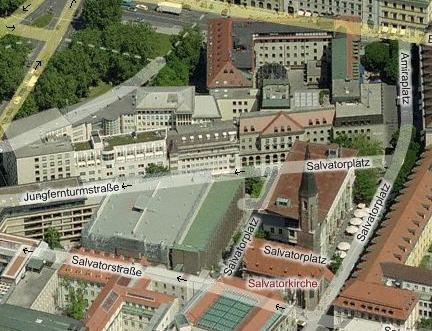

The church was built by Albrecht IV in the year 1494 (below left) as a cemetery chapel for the Church of Our Lady (Frauenkirche.) The church (below center) is squeezed on this corner and the inside (below right) is quite nice.
.jpg)
.jpg)
It is interesting because in 1829 it became a Greek Orthodox church and is now the headquarters of the Metropolitan of Germany and the Exarch of Central Europe. Its name is Transfiguration of the Savior. Below is a closer shot of the altar with the Orthodox icon stands in the forefront.
We wended our way to Jungfernturmstra�e and, because of the plaque, I thought this old wall (below left) was worth photographing. The plaque (below right) says "Here stands the Jungfernturm erected in 1493 and torn down in 1804." The name means Virgin's Tower.
.jpg)
The brickwork doesn't look bad for being over 500 years old. Below left is a better stock photo I found showing the modern building built into the wall. I found a depiction of what the tower looked like before it was demolished (below right.) As you can see, the street we are on was once a waterway.
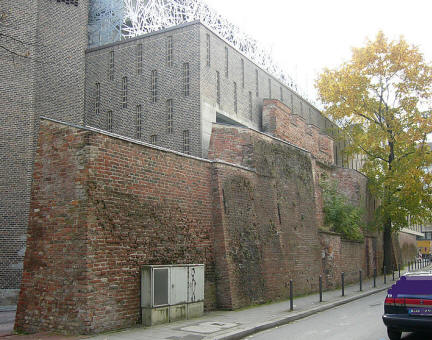
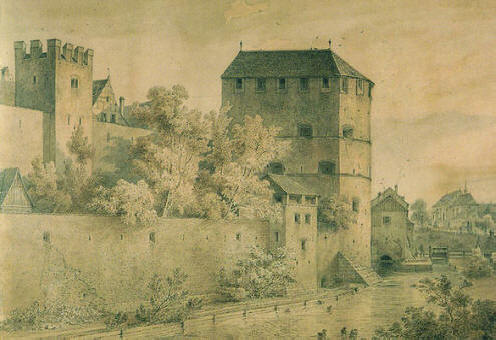
We got back to our room and I must have been exhausted because at 6:10 I laid down for a little in and out dozing until I finally got up and changed and at 7:45 I did my run; this time heading to the Viktualienmarkt area.
I went around the corner into this public square called Sankt Jacobs Platz and as I ran, I passed the Munich Jewish Synagogue. Below are the front (left) and back (right) views of it. The Ohel Jakob synagogue (Hebrew: �Jacob's Tent�) was built from 2004-06 as the new main synagogue of the Munich Jewish community.
It was inaugurated on November 9,
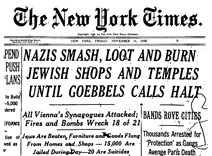
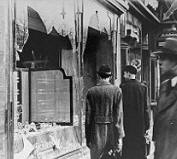 2006,
on the 68th anniversary of
Kristallnacht (The Night of Broken Glass.) Click the link to learn
more about what really happened that horrible day in 1938. Most synagogues
in Germany and Austria were destroyed and thousands of Jews were killed.
Windows of Jewish stores were broken, giving the event its name. The
excuse used by G�bbels for instigating it, was
2006,
on the 68th anniversary of
Kristallnacht (The Night of Broken Glass.) Click the link to learn
more about what really happened that horrible day in 1938. Most synagogues
in Germany and Austria were destroyed and thousands of Jews were killed.
Windows of Jewish stores were broken, giving the event its name. The
excuse used by G�bbels for instigating it, was
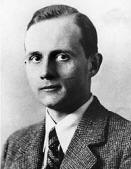
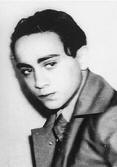 the
assassination two days earlier of German diplomat Ernst vom Rath (left) in Paris
by 17 year-old Herschel Feibel Grynszpan (sometimes spelled "Greenspan,") a
Polish Jewish youth (right,) after learning of the terrible conditions of his
family during their being stranded between the German and Polish border
upon their deportation by Germany. This night was the real beginning of the
"Final Solution" and the Holocaust. Below left is a synagogue in Munich
that was destroyed that night.
the
assassination two days earlier of German diplomat Ernst vom Rath (left) in Paris
by 17 year-old Herschel Feibel Grynszpan (sometimes spelled "Greenspan,") a
Polish Jewish youth (right,) after learning of the terrible conditions of his
family during their being stranded between the German and Polish border
upon their deportation by Germany. This night was the real beginning of the
"Final Solution" and the Holocaust. Below left is a synagogue in Munich
that was destroyed that night.
The Synagogue is part of the new Jewish Center consisting of it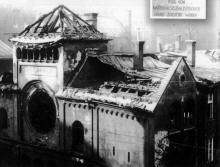 (above,) the
Jewish Museum Munich (below) which is situated between the the synagogue and
the Jewish Community Center. The latter is home to the Jewish Community of Munich and
Upper Bavaria. It houses a public elementary school, a
kindergarten, a youth center as well as a community auditorium and a kosher
restaurant. The museum was built from 2004 until its inauguration on March
22, 2007 and, interestingly, it is run by the City of Munich. Interesting
also is that an alternative to Austria's mandatory national military service, young Austrians
have the opportunity to serve as
Austrian Holocaust Memorial Servants at the Jewish Museum in Munich.
(above,) the
Jewish Museum Munich (below) which is situated between the the synagogue and
the Jewish Community Center. The latter is home to the Jewish Community of Munich and
Upper Bavaria. It houses a public elementary school, a
kindergarten, a youth center as well as a community auditorium and a kosher
restaurant. The museum was built from 2004 until its inauguration on March
22, 2007 and, interestingly, it is run by the City of Munich. Interesting
also is that an alternative to Austria's mandatory national military service, young Austrians
have the opportunity to serve as
Austrian Holocaust Memorial Servants at the Jewish Museum in Munich.
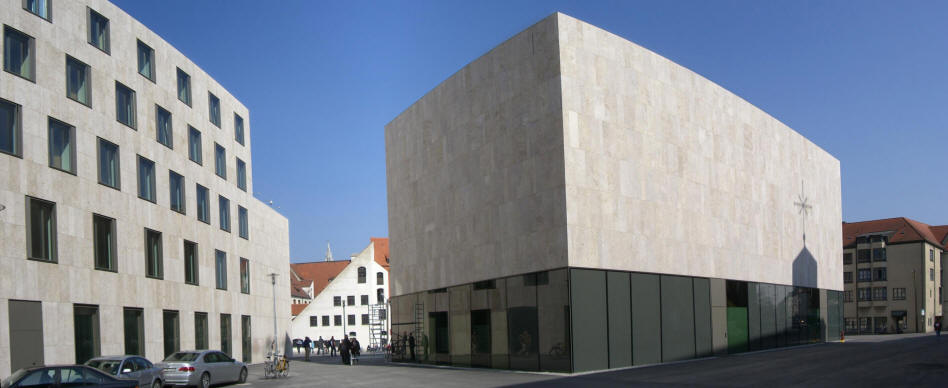
Then, because of its architecture, I took a photo of the Orag-Haus. It houses ORAG eG Bayerische Schneidergenossenschaft (or the ORAG eG Schneider Bavarian cooperative) which is a textile tailoring cooperative that supplies schools, theaters and opera houses as well as private customers.
In the same square as the synagogue, I came across
 this
large building (below.) The
Munich Stadtmuseum [1 St. Jakobs Platz, +49-892-332-2370] is the city museum
of Munich which was founded in 1888 by Ernst von Destouches and is located in
the former municipal arsenal and stables; both buildings of the late Gothic
period. The museum contains the Cultural History of Munich, National
Socialism in Munich ["Hauptstadt der Bewegung" (Capital of the Nazi Movement,)]
a Music collection (2.000 musical instruments,) a Puppet theatre collection,
a Photography collection (>500.000 photographs since 1963) and the Museum of Film.
A lot to see.
this
large building (below.) The
Munich Stadtmuseum [1 St. Jakobs Platz, +49-892-332-2370] is the city museum
of Munich which was founded in 1888 by Ernst von Destouches and is located in
the former municipal arsenal and stables; both buildings of the late Gothic
period. The museum contains the Cultural History of Munich, National
Socialism in Munich ["Hauptstadt der Bewegung" (Capital of the Nazi Movement,)]
a Music collection (2.000 musical instruments,) a Puppet theatre collection,
a Photography collection (>500.000 photographs since 1963) and the Museum of Film.
A lot to see.
They also have an exhibit noting the 200th Anniversary of Das Oktoberfest in Munich (sign below.) I think the chicken is saying "I like you." But why?
.jpg)
Oktoberfest originally started in 1810 as a horse race to celebrate the marriage of the Crown Prince. Then, in 1811, it became the Central Agricultural Fair and since 1819 it has been run by the city of Munich. You can see the entire exhibition for �6 (�3 senior.) Unfortunately, I never got a chance to see it. Here are two stock photos I found of this building which, as you can see, is rather large.
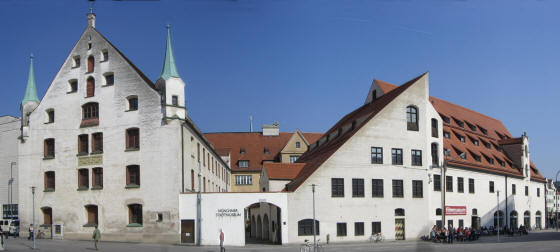
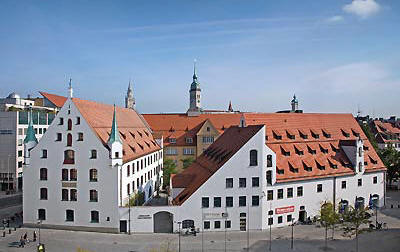
I then passed this building (below) whose ground floor houses a L�wenbr�u beer hall called L�we am Markt Gastst�tten (Lion on Market Pub) [4 Dreifaltigkeitsplatz, +49-8-922-4911.] It looks like a fun place but I never went in.
.jpg)
I got this shot (above right) of the Altes Rathaus [15 Marienplatz,] the Old Town Hall, which serves today as a building for the Munich city council. It bounds the central square Marienplatz on its east side (below.)
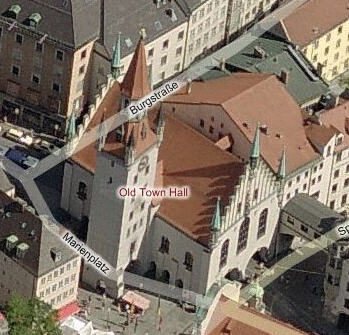
The first documented mention of this building was in 1310. Below left is the beautifully restored clock on the tower. The Grand Hall (Gro�er Saal,) constructed in 1392-4 (below right,) is noted for its intricately beamed ceiling and was the venue for the speech by Joseph G�bbels on November 9th, 1938 which was the prelude for Kristallnacht.
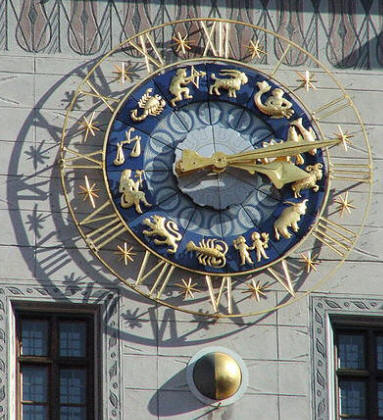

I found some interesting old depictions of the building over the years. Below left is from 1710 and below right is from 1860.
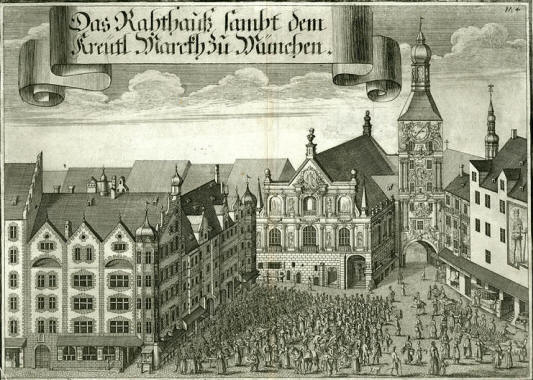

Below left is from the 1900s, in the center is from 1910 and below right is a photograph from 1923 before it was bombed.

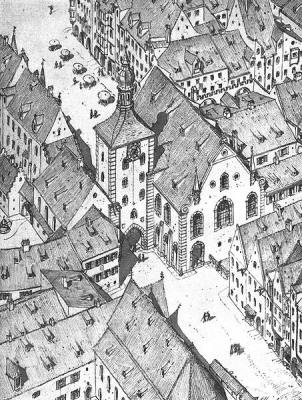
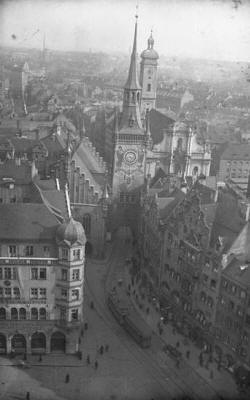
The former Talburg Gate (Talburgtor) of the very first city wall serves as its spire and is 180 ft (55 m) tall. It was re-designed in late-gothic style by J�rg von Halsbach from 1470-80. After alterations of the fa�ade during the Renaissance, the building was restored in neo-gothic style in 1861-4. In 1874 the city government moved to the New Town Hall. For the passage of increased road traffic the building was tunneled in 1877 and again in 1934. During World War II the building was severely damaged and the spire was reconstructed in 1971-4. The tower houses a fun toy museum (Spielzeugmuseum,) situated in four rooms.
On my way back, I saw this other tower (below left) as I went down this narrow street. It is Old Peter.
Sankt Peter's Church (above right) is a Roman Catholic church and the oldest
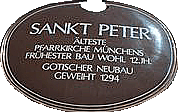 church
in Munich's inner city. The parish church of Saint Peter, whose tower is
commonly known as "Alter Peter" is a symbol of the city because it is considered
the originating point for the whole city. Before Munich was founded in
1158, there was a pre-Merovingian
church here. 8th Century monks lived around the original church on this hill
called Petersbergl. Below you can see St. Peter's and next door
Heiliggeistkirche.
church
in Munich's inner city. The parish church of Saint Peter, whose tower is
commonly known as "Alter Peter" is a symbol of the city because it is considered
the originating point for the whole city. Before Munich was founded in
1158, there was a pre-Merovingian
church here. 8th Century monks lived around the original church on this hill
called Petersbergl. Below you can see St. Peter's and next door
Heiliggeistkirche.
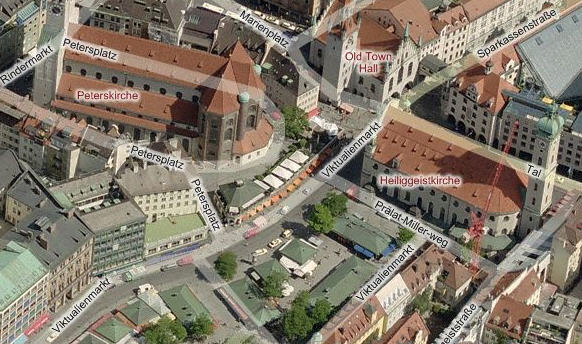
Otto I of Wittelsbach had the church extended in 1181
and it was consecrated in 1190 by Bishop Otto II of Freising. At the end
of the 12th Century, a new

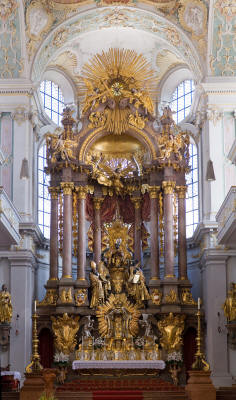 church
was begun in the Bavarian Romanesque style, was consecrated on May 17, 1294 by
Bishop Emicho of Freising, and later expanded in Gothic style shortly before the
great fire destroyed it in 1327. A hundred years later, this building was torn
down and replaced with a more ostentatious church. A substantially bigger
church was not necessary, because Cathedral Frauenkirche (Church of Our Lady)
was being planned not far away. After its reconstruction, the church
was dedicated again in 1368. In the early 17th century, the 302 ft (92 m)
spire received its Renaissance steeple top and a new Baroque choir was added.
church
was begun in the Bavarian Romanesque style, was consecrated on May 17, 1294 by
Bishop Emicho of Freising, and later expanded in Gothic style shortly before the
great fire destroyed it in 1327. A hundred years later, this building was torn
down and replaced with a more ostentatious church. A substantially bigger
church was not necessary, because Cathedral Frauenkirche (Church of Our Lady)
was being planned not far away. After its reconstruction, the church
was dedicated again in 1368. In the early 17th century, the 302 ft (92 m)
spire received its Renaissance steeple top and a new Baroque choir was added.
The high altar (above right) was designed by E. Q. Asam, who you remember from the Assamkirche and Asamhaus. You can visit the tower M-F (9-6) and S-S (10-6) and below are the views you get from the top.
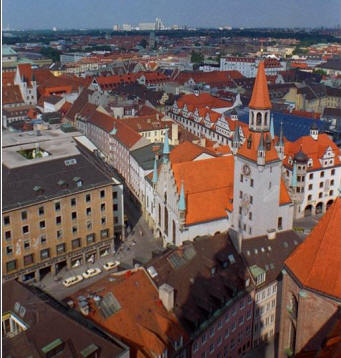
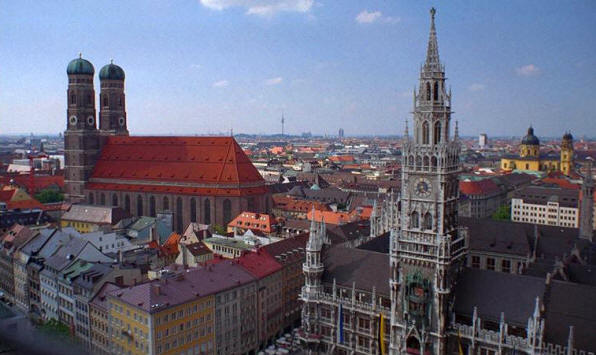
I got back to the room, changed and at 8:00 Marcia was relaxing and enjoying a glass of Pinot Grigio at one of the outdoor tables at Asado Steak [Am F�rbergraben, +49-893-816-9038] while waiting for me to return.
.jpg)
We left there and wended our way back to the Viktulienmarkt area to enjoy some typical Bavarian fare. As you can see at 8:45 we are not alone in wanting to enjoy a relaxing outdoor meal.
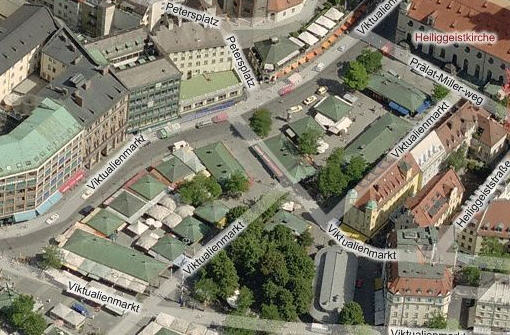
Above you can see how large this market area is. During the day it is full of vendors selling everything and at night it is devoted to eating and drinking.
There are many choices but we settled on the M�nchener Schmankerl serving Munich specialties (specialat�ten.)
.jpg)
I knew what I was hungry for: two M�nchener helles beers, 5 bratwursts with sauerkraut and finally, a Schweinhaxn mit kartofelnsalat. It was all fairly good.
Marcia had three white wines, and three bratwursts with kartofelnsalat.
It was funny. While I was photographing Marcia (below left,) this young lady at the next table was worried I was photographing her. She's staring right at me (right.)
After they closed it was interesting to see how carefully these ladies cleaned up the food stall; they were scrubbing like crazy.
After relaxing and enjoying our food and the crowd, at 10:45 we headed back to our hotel and stopped at a HypoVereinsbank ATM to get some more Euros. We got to bed at 11:00 PM which is pretty early for me, but I guess all that walking wore me out.
Kenneth J. Hoffer, MD
Munich, Germany
8/20/2010
Sent 2-05-2011
If you enjoyed these travels or wish to add comments on the places we visited
Please Leave Me a Message by clicking the spinning @ sign below.

